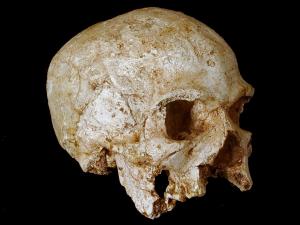Reliably dated fossils are critical to understanding the course of human evolution. A human skull discovered over fifty years ago near the town of Hofmeyr, in the Eastern Cape Province of South Africa, is one such fossil. A study by an international team of scientists led by Frederick Grine of the Departments of Anthropology and Anatomical Sciences at Stony Brook University in New York published in Science magazine has dated the skull to 36,000 years ago. This skull provides critical corroboration of genetic evidence indicating that modern humans originated in sub-Saharan Africa and migrated about this time to colonize the Old World. (Science January 12, 2007) 'Out Of Africa' Theory Boost: Skull Dating Suggests Modern Humans Evolved In Africa
The Hofmeyr Skull. Scientists have now dated the skull as being 36,000 years old. The great similarity of this skull to skulls of the same age from Eurasian finds confirms the "Out of Africa"-hypothesis. Modern humans broke out of their place of origin around 40,000 years ago - from Africa south of the Sahara - and populated the world. (Image: Frederick E. Grine)"The Hofmeyr skull gives us the first insights into the morphology of such a sub-Saharan African population, which means the most recent common ancestor of all of us - wherever we come from," said Grine.
Although the skull was found over half a century ago, its significance became apparent only recently. A new approach to dating developed by Grine team member Richard Bailey and his colleagues at Oxford University allowed them to determined its age at just over 36,000 years ago by measuring the amount of radiation that had been absorbed by sand grains that filled the inside of the skull’s braincase. At this age, the skull fills a significant void in the human fossil record of sub-Saharan Africa from the period between about 70,000 and 15,000 years ago. During this critical period, the archaeological tradition known as the Later Stone Age, with its sophisticated stone and bone tools and artwork appears in sub-Saharan Africa, and anatomically modern people appear for the first time in Europe and western Asia with the equally complex Upper Paleolithic archeological tradition.
In order to establish the affinities of the Hofmeyr fossil, team member Katerina Harvati of the Max Planck Institute for Evolutionary Anthropology in Leipzig, Germany, used 3-dimensional measurements of the skull known to differentiate recent human populations according to their geographic distributions and genetic relationships. She compared the Hofmeyr skull with contemporaneous Upper Paleolithic skulls from Europe and with the skulls of living humans from Eurasia and sub-Saharan Africa, including the Khoe-San (Bushmen). Because the Khoe-San are represented in the recent archeological record of South Africa, they were expected to have close resemblances to the South African fossil. Instead, the Hofmeyr skull is quite distinct from recent sub-Saharan Africans, including the Khoe-San, and has a very close affinity with the European Upper Paleolithic specimens.
The field of paleoanthropology is known for its hotly contested debates, and one that has raged for years concerns the evolutionary origin of modern people. A number of genetic studies (especially those on the mitochondrial DNA) of living people indicate that modern humans evolved in sub-Saharan Africa and then left between 65,000 and 25,000 years ago to colonize the Old World. However, other genetic studies (generally on nuclear DNA) argue against this African origin and exodus model. Instead, they suggest that archaic non-African groups, such as the Neandertals, made significant contributions to the genomes of modern humans in Eurasia. Until now, the lack of human fossils of appropriate antiquity from sub-Saharan Africa has meant that these competing genetic models of human evolution could not be tested by paleontological evidence.
The skull from Hofmeyr has changed that. The surprising similarity between a fossil skull from the southernmost tip of Africa and similarly ancient skulls from Europe is in agreement with the genetics-based "Out of Africa" theory, which predicts that humans like those that inhabited Eurasia in the Upper Paleolithic should be found in sub-Saharan Africa around 36,000 years ago. The skull from South Africa provides the first fossil evidence in support of this prediction.
Reference: F.E. Grine, R.M. Bailey, K. Harvati, R.P. Nathan, A.G. Morris, G.M. Henderson, I. Ribot, A.W.G. Pike. Late Pleistocene Human Skull from Hofmeyr, South Africa and Modern Human Origins. Science, 12. January 2007
* * * Additional authors include Alicia Oshlack, Gordon Smyth and Terence Speed from the Hall Institute in Parkville, Victoria, Australia. This study was supported grants from the Keck Foundation, the Beckman Foundation and the National Human Genome Research Institute to Professor White.
HOME
HedWeb
HerbWeb
Primate Info
Chimpanzees
Primate Species
Homo floesiensis
Animal Rights FAQ
Planet of the Apes
Paradise-Engineering
Bonobos and Humans
Neanderthal-Man.com
Primates and Primatology Hotlinks
Human and Chimpanee DNA Compared
A tribe of 200 who crossed the Red Sea 70,000 years ago?
dave@bltc.com

